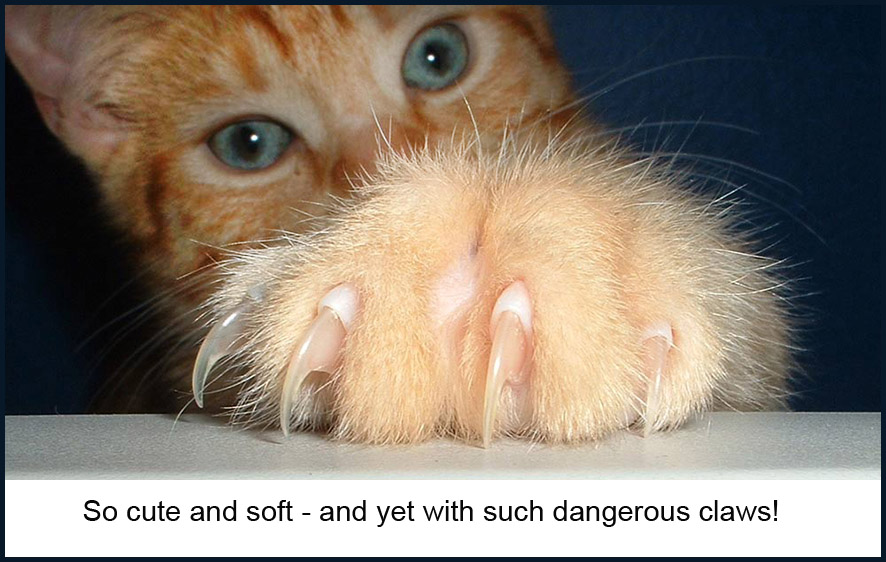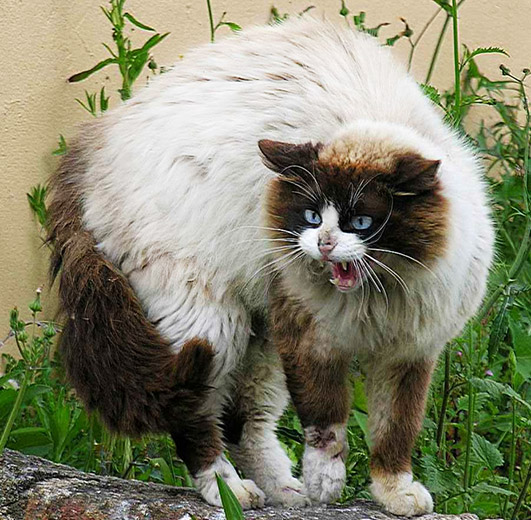Looking for some interesting facts about cats?
The cats facts that follow will give you some interesting insights into the lives of felines – as well as giving you a few surprises. Be prepared to look at cats in a whole new light!
Cats have been a favored pet in households throughout dozens of civilizations for thousands of years.
From the royal pets of the ancient Egyptians to the modern house cats of today, these friendly creatures have provided warmth and love to their human owners.
(Some cat owners would say their pets actually own them!).

Maybe you think you know cats? Here below are some fascinating cat facts some of which you might not have heard before:
Fun and Interesting Facts about Cats
1. Cats are carnivores – that means they mostly eat meat.
Well, this first one I guess you already know, but what about the next ones?
2. Cats sleep for a significant portion of their lives – 16 to 18 hours a day, on average
3. Cats can move at up to 30 miles (48 kilometers) per hour in little bursts (usually when attacking prey)
4. Cats have excellent hearing, including the ability to hear ultrasonic sound which even dogs can’t pick up
5. More than half the homes in the United States have a pet cat
6. Cats don’t have the taste buds for picking up sweet flavors
7. Every cat has its own unique ‘noseprint’
8. France launched a cat into space in 1963, named Felicette
9. Cat purrs indicate happiness, although in some cases cats purr when they’re stressed or afraid
10. The Turkish van is a breed of cat with a special, water-resistant coat
11. Cats are well-known for their impressive jumping abilities, with some cats being able to jump five times their own height in one leap
12. Isaac Newton is most famous for his theories about physics and gravity – but he also invented the Cat Door.
13. A cat’s whiskers are used for feeling in general, but specifically the cat uses them to judge how much space is available around her and whether or not she can fit through gaps
14. The fastest ‘big cat,’ the cheetah, can run at about 75 miles (120 kilometers) per hour
There’s a few fun facts about cats to get you started – read on to learn more about different breeds of cats, some interesting cat behavior facts and why ancient Egyptians became so obsessed with their feline companions.
Types of Cats
There are 73 recognizable breeds of cat in the world (although some organizations only acknowledge around 40 of these as official breeds).
This is a much smaller numbers than dogs (there are over 400 breeds of dog).
The difference comes from the fact that dogs have been actively used for a variety of different purposes throughout history, and they have been bred to develop particular traits. Cats, on the other hand, have generally been either pets or pest control (or a little of both), so selective breeding has not been as intensive in cats as it has been in dogs.
There are too many types of cats to go into detail on every one here – but here are some fun and interesting facts about several particularly well-known or unusual types of cats:
The Bengal cat is a hybrid breed famous for its spots, which mini it look like a miniature leopard
The Don Sphynx is a hairless cat breed which originates from Russia

The Kurilian Bobtail is another Russian cat, with a fluffy coat and a short, bobbed tail which make it resemble a smaller version of a lynx or snow leopard
The Munchkin is a breed of American origin known for its short, stubby legs
The Oriental short hair is known for its distinctive appearance, with thin body and limbs, very short coat, narrow pointy nose and large bat-like ears
The Singapura from Indonesia has large, pointy ears that stick straight up from its head
The Toyger is an American designer breed, created deliberately to resemble a small tiger
Below you can read about cat training and walking your cat with a leash, but just for the fun of it, here is a video with a 7-step guide to walking your human:
Cat Behavior
Now we’re about to get into some key facts about common cat behaviors. Be warned though – you might end up questioning whether your pet loves you as much as you originally thought!
For example – if you have a pet cat, you’ve probably found her rubbing up against your legs on occasion. She does that to show you affection, right?
Well, not necessarily. Cats have scent glands around their faces which they use to mark their territory. So when your cat rubs on you like this, he’s not just saying hello. In a way, he’s actually laying claim to you as his property!
Here’s another interesting fact about cats: In addition to purring when they’re happy, cats will also squeeze their eyes shut.

Amongst common cat behavior problems are house soiling and aggression.
House soiling is probably the most common, and also happens to be the easiest to deal with. Most cat owners choose to house train their cat using a litter box.
A kitten should be house trained when she is taken from her mother, aged 12 weeks.
This is actually the best age to have her, as she then will have learned what she need to know from her mother, although kittens are often taken away sooner.
This means that you have to learn her the cat toilet training yourself.
To litter train a new kitten you’ll need to place her on the litter box regularly throughout the day, especially after drinking and meals, and give her praise when she ‘goes’ in the right place.
When a cat isn’t using the litter box (even though she knows how to), it may indicate the litter isn’t being changed often enough. Cats are picky about going to the toilet in a ‘dirty’ litterbox!
If a cat has an accident, though, it pays to pick up the ‘mess’ and put it in the litterbox before cleaning the litter out to reinforce the training message.
Aggression is a little harder to solve, and may include keeping tight control over a cat’s environment and even enlisting the help of a cat behavior professional.
Weird Cat Behavior
Many cat owners get frustrated with the habit cats have of scratching at carpet or furniture. It’s a good idea to buy a scratching post and teach your cat to use it – but why do cats do this in the first place?

The usual answer given is ‘to sharpen their claws,’ and this is true – that is one reason they do it.
But research has indicated that the main reason for scratching is – once again – territory marking. Cats will scratch up trees, fences and furniture just to let other cats know that’s their turf.
Another unusual cat behavior many owners are frustrated by is grass-eating.
This can be especially distressing to a cat owner, because usually the animal throws up the grass again soon after eating it.
The answer to this isn’t exactly clear, but it seems there may be a few reasons cats eat grass. One is to get essential nutrients which they wouldn’t otherwise get enough of from their diet, such as folic acid. It also appears to be a kind of natural digestive system clean-out. The cat regurgitates grass because, as a carnivore, it can’t digest vegetation – and when the grass comes back out, it brings with it other indigestibles that may be clogging up the cat’s digestive tract.
Ever heard strange crying noises at night and wondered what on Earth it could be – only to realize it’s a cat?
Cats have an impressive vocal range and are able to create a much wider variety of sounds than dogs. This is why cats are not only able to create short, sharp ‘meows’ when they’re hungry, but also screech, howl, and make noises that sound eerily like a baby crying.
Can Cats Be Trained?
There’s a long-running rivalry between ‘cat people’ and ‘dog people,’ and one of the main arguments dog people often use against owning cats is that they ‘can’t be trained.’
This is one of those facts about cats that isn’t really a fact after all. While many cats are resistant to any form of obedience training, it’s not true that cats can’t be trained.
They can be trained to perform certain behavior in exactly the same way dogs are: using associations and rewards to reinforce or discourage behavior.
Training a cat successfully simply requires that you find the right kind of reward, to give the cat enough motivation to take part in training.
The reason many cat owners find their cat ‘can’t be trained’ is simply that they aren’t using treats or rewards that the cat actually cares about.
If you want to have a cat you can take for a walk, you should start introducing her to a cat harness and a cat leash as soon as possible, because if you try that on an adult cat, you will have huge problems.
See this video about how to train your cat to walk with a cat harness and cat leash:
Cat Illnesses
Our facts about cats page wouldn’t be complete without a look at cat health.
Let’s now take a quick look at some common health problems that can affect cats, as well as some methods you can use to deal with problems like cat constipation.
One of the most common problems in cat is the UTI – urinary tract infection.
Symptoms can include an apparent loss of bladder control in a cat who is otherwise well house trained, and blood in the cat’s urine.
Although they may not seem particularly serious, UTIs can lead to further health complications if they’re left untreated.
Your best bet is to visit the vet for a checkup – if your cat does have a UTI, the vet will prescribe a round of antibiotics.
Cat constipation can be a symptom of a serious illness, or it can simply be caused by the cat eating something outside its ordinary diet.
When it comes to constipation, you need to look at what other symptoms are present, if any.
If the constipation is not accompanied by other symptoms, your best initial reaction is to make more water available to your cat and keep an eye on what she’s eating, then monitor the results.
However if other symptoms are present, such as vomiting, excessive meowing, and loss of appetite, it might warrant a trip to the vet.
Respiratory infections are another common problem in cats which every owners should be aware of.
While its normal for cats to cough up the occasional hairball, a cat with a fever, an unusual cough and a runny nose may be suffering from a respiratory infection.
Lethargy and a lack of interest in food and water can also be symptoms.
Again, a trip to the vet should result in a round of antibiotics being prescribed to clear this up.
Cat Deterrents
Cat deterrents or repellers are devices which have become popular in areas plagued by stray cats, but some cat owners also use them around the home.
The device is designed to keep cats away from a particular area, usually by emitting a high-pitched sound only cats can hear. Other devices use smells or electricity to keep cats away, rather than sound.
There are several advantages to cat deterrents – for starters, they can help you protect a garden.
In fact, these devices are most popular with landscapers or hobby gardeners because they help ensure your well-meaning pet cat doesn’t destroy all your hard work and ruin your flowers or vegetables.
There are also a couple of points to be aware of if you plan on using a cat deterrent, however.
It’s not recommended that you use electric fences, as these can cause harm to cats and are not particularly humane.
The most effective cat deterrents are the ones which use ultrasound,( this of course won’t work if your cat happens to be deaf).
If you’re using a deterrent at home, you also need to be aware of the range.
You only want the ultrasound to affect the general area you’re trying to keep the cat away from.
If the range of the deterrent is too large, you’ll cause your cat unnecessary discomfort even when she’s not on your garden patch, and may even force her to want to stay away from your home.
Also, remember that you don’t have to use a device that fixes in one place – there are now portable cat repellers which achieve the same effect as a fixed device.
Known as ‘scatter guns,’ these devices also use high-pitched sound and are often use to get rid of stray cats.
Facts About Cats in Ancient Egypt
As we’ve already touched on throughout this article, cats played an important role in ancient Egyptian society, including their myths and legends.
Here are some facts about cats in ancient Egypt.

Cats are believed to have first been domesticated in the Middle East, later spreading into Egypt and North Africa.
The ancient Egyptians associated each of their gods with a particular animal, and each god was represented with that animal’s head.
Egyptian cats were symbolic in ancient Egyptian culture, representing many positive traits – which is partly why they were popular pets for important people and royalty.
But they weren’t just kept around because they were snuggly and looked nice – cats also had a practical role to play.
In particular they were given the task of protecting crops against mice, rats and other creatures that could ruin a harvest – even snakes.
The cat goddess of ancient Egypt was called Bast – a figure who represented, among other things, fertility, which may have been linked to the cat’s role in protecting food and crops.
Bubastis was the city which became the centre of cat worshipping, and this city – along with cat worship – reached its height around 500-400BC.
The ancient Egyptians are famous for their practice of mummifying their dead – preserving the bodies for thousands of years. This practice even extended to their beloved cats, with one tomb discovered containing 80,000 individual mummified cats.